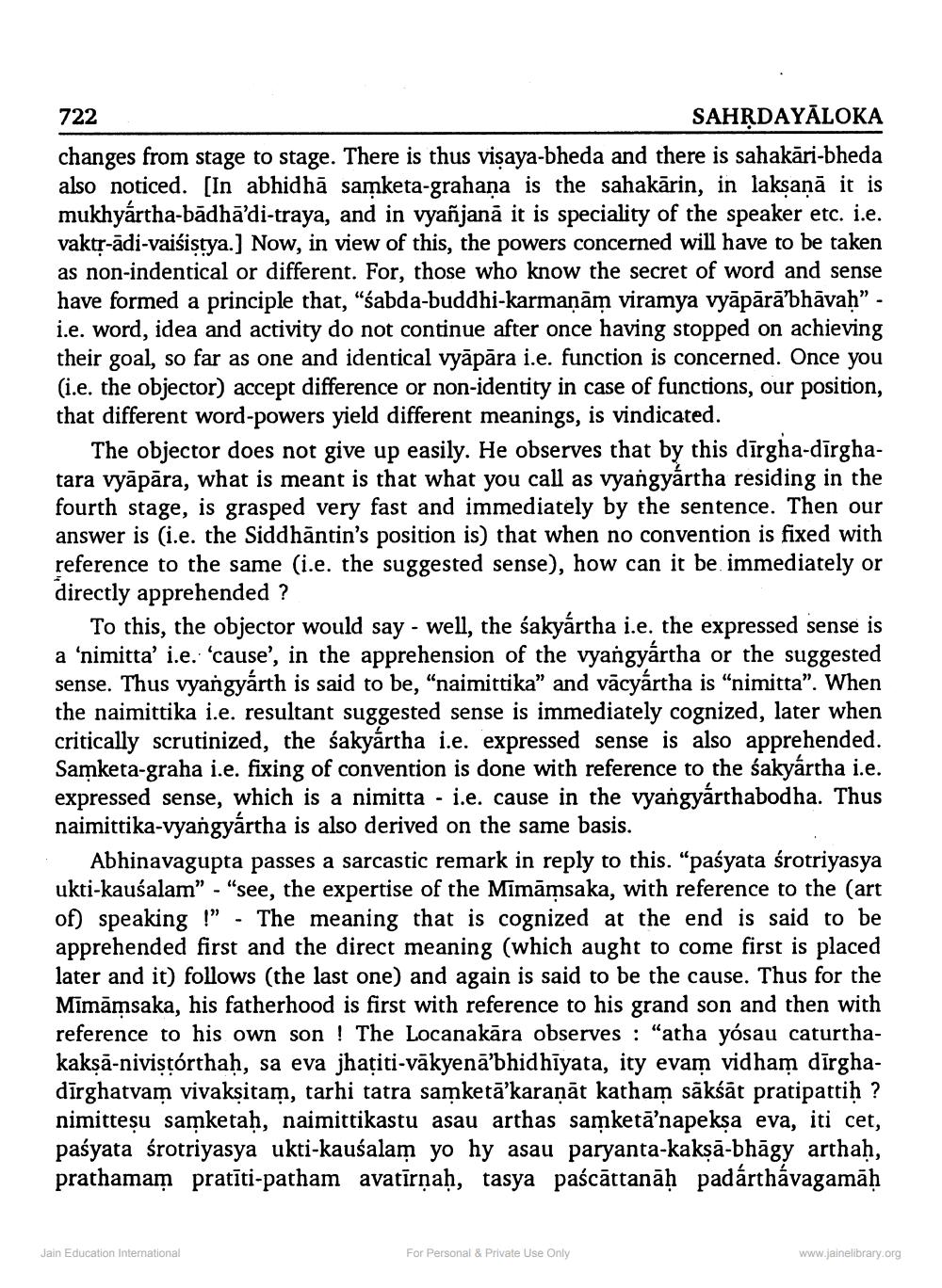________________
722
SAHRDAYĀLOKA changes from stage to stage. There is thus visaya-bheda and there is sahakāri-bheda also noticed. [In abhidhā samketa-grahana is the sahakārin, in laksaņā it is mukhyártha-bādhā'di-traya, and in vyañjanā it is speciality of the speaker etc. i.e. vaktr-adi-vaisistya.] Now, in view of this, the powers concerned will have to be taken as non-indentical or different. For, those who know the secret of word and sense have formed a principle that, “sabda-buddhi-karmaņām viramya vyāpārā’bhāvah” - i.e. word, idea and activity do not continue after once having stopped on achieving their goal, so far as one and identical vyāpāra i.e. function is concerned. Once you (i.e. the objector) accept difference or non-identity in case of functions, our position, that different word-powers yield different meanings, is vindicated.
The objector does not give up easily. He observes that by this dārgha-dīrghatara vyapara, what is meant is that what you call as vyangyartha residing in the fourth stage, is grasped very fast and immediately by the sentence. Then our answer is (i.e. the Siddhāntin's position is) that when no convention is fixed with reference to the same (i.e. the suggested sense), how can it be immediately or directly apprehended ?
To this, the objector would say - well, the sakyártha i.e. the expressed sense is a ‘nimitta' i.e. 'cause', in the apprehension of the vyangyártha or the suggested sense. Thus vyangyárth is said to be, "naimittika" and vācyártha is "nimitta”. When the naimittika i.e. resultant suggested sense is immediately cognized, later when critically scrutinized, the sakyártha i.e. expressed sense is also apprehended. Samketa-graha i.e. fixing of convention is done with reference to the sakyártha i.e. expressed sense, which is a nimitta - i.e. cause in the vyangyárthabodha. Thus naimittika-vyangyártha is also derived on the same basis.
Abhinavagupta passes a sarcastic remark in reply to this. "paśyata śrotriyasya ukti-kauśalam” - "see, the expertise of the Mimāmsaka, with reference to the (art of) speaking !" . The meaning that is cognized at the end is said to be apprehended first and the direct meaning (which aught to come first is placed later and it) follows (the last one) and again is said to be the cause. Thus for the Mimāmsaka, his fatherhood is first with reference to his grand son and then with reference to his own son ! The Locanakāra observes : "atha yósau caturthakaksā-nivistórthah, sa eva jhatiti-vākyenā'bhidhīyata, ity evam vidham dirghadīrghatvam vivaksitam, tarhi tatra samketā'karanāt katham sākśāt prat nimittesu samketah, naimittikastu asau arthas samketā'napeksa eva, iti cet, paśyata śrotriyasya ukti-kauśalam yo hy asau paryanta-kaksā-bhāgy arthaḥ, prathamam pratīti-patham avatīrṇaḥ, tasya paścāttanāḥ padárthávagamāḥ
Jain Education Interational
For Personal & Private Use Only
www.jainelibrary.org




